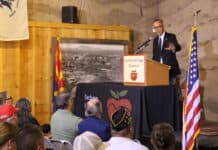After 14 days of a full forest closure, the Coconino National Forest reopened at 6 a.m. on Tuesday, July 6. Around the Sedona area, much of the forest received between 0.5 and 1.2 inches of rainfall over the weekend and last week, helping squelch much of the near-fully-contained Rafael Fire burning on the Coconino Plateau.
Rainfall varies widely in the high desert, unlike other parts of the country where a big storm dumps nearly equal amounts over a large area. Uptown got a major rainfall dump last week while the Village of Oak Creek barely got a drop.
On Sunday, July 4, the Cottonwood area was relatively dry while Sedona was getting pounded with the heavy downpour until just before the fireworks were scheduled to begin, with some readers reaching out to us to ask if fireworks would be canceled due to the downpour. At the tail end of last week, while Sedona had blue skies, rain was extinguishing the northern perimeter of the Rafael Fire, much to the relief of fire crews still on the line.
Coconino National Forest managers decided with the rainfall — as patchy and spotted as it was — was still sufficient enough to lower the fire risk to allow the forest to reopen.
They made their announcement the afternoon of Monday, July 5, that the forest would be reopened the following morning.
So even though the full forest closure has been lifted, it doesn’t mean everything is back to normal. The Coconino National Forest remains under Stage II fire restrictions.
The desert Southwest has been in a drought since either 2019, after a decades-long drought, or the drought that started in 2001 never really ended, depending on which government climate source you trust. A 20-year temporary weather change may not be temporary and we should just assume the low-rainfall climate we have is just how things are now.
The full forest closure did expose an economic problem that most of us in Sedona choose to turn a blind eye to, and which city leaders blissfully ignore as a matter of policy.
Dozens of Sedona workers live on forest land either by choice or economic circumstance. We highlighted the struggle of some members of this population in last week’s paper.
The Coconino National Forest is public land, but it is not meant to be a place for people to live indefinitely. The forest is a recreation area and nature preserve. These occupation limits aim to prevent overuse, protect wildlife and limit the damage done by humans, our vehicles and our gear. Nearly all National Forests have a limit of a two-week visit within in a 30-day period, with the implied understanding that those who choose to camp on our shared land will return home or leave that forest once their two-week stay is over. Coconino only has a handful of law enforcement personnel to police an area larger than Delaware.
National Forests do not encourage campers to live there permanently, yet many in the Sedona area choose to, or feel they are forced to rather than move somewhere they could find permanent housing.
In the past, some simply picked up every two weeks to move to another forest. After the Prescott National Forest banned camping in a large swath of the Verde Valley, regular visitors, RVers and these clandestine workers could only find sites on the Coconino National Forest.
The majority of campers using the forest during the height of the COVID-19 pandemic were recreationists escaping the cities for a long vacation, camouflaging the number of resident campers.
With the full forest closure, however, the problem of homeless car campers living secretly on the forest overwhelmed law enforcement dealing with camping and lack of homeless shelters in nearby cities, creating a small humanitarian crisis, only exacerbated by Sedona city officials giving false hope and tacit support that public camping in city limits would be excused.
With the forests reopened, many will return to the public lands beyond city limits.
City officials won’t build a shelter nor safe camping parking area and certainly won’t alter any ordinances.
Federal forest officials will still be overworked and understaffed.
And the underlying issue of homelessness can again be safely ignored until next fire season.
Christopher Fox Graham
Managing Editor



















